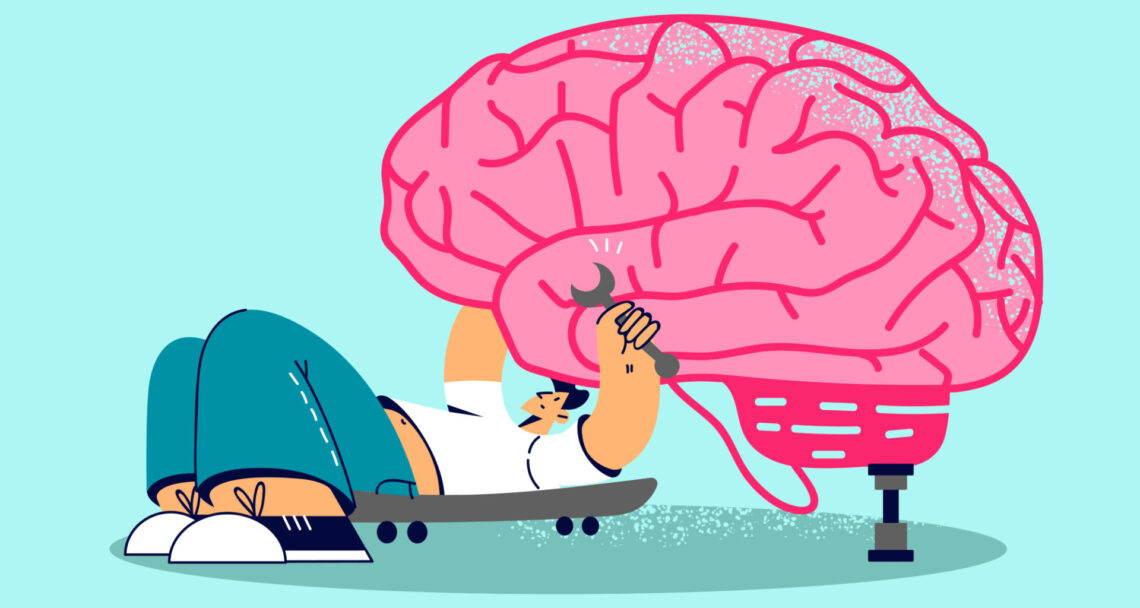The brain’s extraordinary ability to adapt and reorganize itself is a phenomenon known as neuroplasticity. Contrary to earlier beliefs that the brain’s structure and function were fixed after a certain age, research has shown that the brain remains malleable throughout life. This adaptability is driven by various factors, including experiences, learning, and environmental influences.
Neuroplasticity encompasses both structural and functional changes in the brain. At the structural level, it involves the formation of new neural connections and the remodeling of existing ones. This process, known as synaptic plasticity, is crucial for learning and memory. Functionally, neuroplasticity allows the brain to redistribute tasks and functions, compensating for damage or adapting to new challenges. Understanding the mechanisms behind neuroplasticity opens up exciting possibilities for cognitive enhancement and rehabilitation.
While the concept of neuroplasticity is widely recognized, its underlying mechanisms are complex and multifaceted. One prominent factor is the role of neurotransmitters, the chemical messengers that transmit signals between neurons. The release and reception of neurotransmitters play a pivotal role in strengthening or weakening synaptic connections. Additionally, neurotrophic factors, proteins that support the growth, survival, and differentiation of neurons, contribute significantly to neuroplasticity. As researchers delve deeper into these intricate processes, the potential for targeted interventions to harness neuroplasticity for therapeutic purposes becomes increasingly promising.
Training-Induced Changes: Shaping the Brain through Experience

One of the most compelling aspects of neuroplasticity is its responsiveness to training and experience. Engaging in specific activities or cognitive exercises can induce notable changes in the brain’s structure and function. For instance, studies have demonstrated that learning a new skill, such as playing a musical instrument or acquiring a new language, leads to the expansion of certain brain regions associated with the practiced task.
The process of training-induced neuroplasticity involves a series of steps. Initially, there is an increased activation of neurons related to the specific activity. As practice continues, the synaptic connections involved in the task are strengthened, leading to more efficient signal transmission. Over time, structural changes may occur, such as the growth of new dendritic spines or even the generation of new neurons in certain brain regions. This ability of the brain to remodel itself in response to deliberate practice has profound implications for education, rehabilitation, and skill acquisition. A science tutor in Boulder explains this principle in detail to his senior students.
Beyond cognitive skills, physical exercise has also been shown to induce neuroplastic changes. Aerobic exercise, in particular, has been linked to increased hippocampal volume, a region critical for learning and memory. Understanding how different types of activities influence the brain’s plasticity provides valuable insights for designing personalized interventions to enhance cognitive function and overall well-being.
Cognitive Rehabilitation: Harnessing Neuroplasticity for Recovery
Neuroplasticity plays a pivotal role in cognitive rehabilitation, offering hope for individuals recovering from brain injuries or neurological disorders. Following trauma or damage to the brain, the unaffected areas can undergo functional and structural adaptations to compensate for the lost functions. This inherent ability of the brain to reorganize itself forms the basis for rehabilitation strategies aimed at maximizing recovery. After a car accident, the transmission service in Buffalo will take care of the car, but a good doctor is necessary for a person to recover, especially from head injuries.
Various therapeutic approaches leverage neuroplasticity to promote rehabilitation. Constraint-induced movement therapy, for example, restricts the use of the unaffected limb, compelling the patient to rely on the impaired limb and encouraging the brain to reorganize to support motor function. Similarly, cognitive training exercises target specific cognitive functions, stimulating adaptive changes in the neural circuits involved. The integration of technology, such as virtual reality, into rehabilitation programs further enhances the effectiveness of neuroplasticity-based interventions.
As research advances, the field of cognitive rehabilitation continues to evolve, offering tailored solutions for individuals with diverse neurological challenges. Recognizing the intricate interplay between the brain’s plasticity and therapeutic interventions opens avenues for innovative treatments and improved outcomes for those on the path to recovery.
The Future of Neuroplasticity Research: Implications and Challenges
The exploration of neuroplasticity has far-reaching implications for fields ranging from education to medicine. As our understanding deepens, opportunities for enhancing cognitive abilities, treating neurological disorders, and optimizing learning experiences will likely expand. The health clinic in Marietta GA already has certain advanced devices for the treatment of brain and head trauma. However, with these opportunities come challenges and ethical considerations.
One challenge lies in deciphering the individual variability in neuroplastic responses. Not all brains respond to training or experiences in the same way, and factors such as genetics, age, and overall health play crucial roles. Unraveling the complexity of these interactions is essential for tailoring interventions to specific individuals effectively.
Ethical considerations also come into play as neuroplasticity-based interventions advance. Selling business advisors invest in the story of jobs related to this profession and the issue cautiously, advising their clients to start such a business exclusively with a humane intention. Questions about cognitive enhancement, the potential for unintended consequences, and issues of accessibility and equity must be addressed responsibly. Striking a balance between scientific progress and ethical considerations will be paramount as researchers and society navigate the evolving landscape of neuroplasticity research.
Exploring Neuroplasticity in Education: Enhancing Learning Environments
Expanding our understanding of neuroplasticity opens up innovative avenues in education. Traditional educational models often overlook individual differences in learning styles and preferences. On the other hand, homeschooling tutors in Bettendorf take the task of imparting knowledge to students very seriously. Neuroplasticity research suggests that tailoring teaching methods to leverage the brain’s adaptability could significantly enhance the learning experience.
Implementing neuroplasticity-informed strategies involves creating dynamic learning environments that engage students in a variety of ways. Beyond conventional classroom instruction, incorporating interactive activities, real-world applications, and technology-driven resources can stimulate diverse neural pathways. Adaptive learning platforms, for instance, can dynamically adjust content based on individual progress, optimizing the learning process and fostering a deeper understanding of subjects. Readathon school fundraiser advocates encouraging students to learn through reading interesting content.
Furthermore, recognizing the impact of emotional and social factors on neuroplasticity underscores the importance of fostering a positive and supportive learning atmosphere. Social interactions, emotional well-being, and stress management all contribute to the brain’s adaptability. Educators can play a crucial role in creating an environment that nurtures not only intellectual growth but also emotional intelligence, enhancing overall cognitive resilience.
Neuroplasticity and Mental Health: Implications for Well-Being

The relationship between neuroplasticity and mental health unveils new possibilities for understanding and treating various psychological conditions. Research indicates that experiences and interventions can influence the brain’s plasticity, offering potential avenues for therapeutic interventions. Experience is something that helps us in life and makes it easier to deal with everyday problems. If some unexpected accidents occur, such as a burst pipe in an apartment, the experience and knowledge of emergency restoration services in Charlotte will help us quickly solve the problem.
Cognitive behavioral therapy (CBT), a widely used approach in mental health treatment, aligns with neuroplasticity principles. By targeting maladaptive thought patterns and behaviors, CBT aims to rewire neural circuits, promoting more adaptive responses to stressors and challenges. The integration of neurofeedback, a technique that provides real-time information about brain activity, further refines therapeutic approaches, allowing for personalized interventions tailored to an individual’s neural responses.
Moreover, exploring the impact of mindfulness practices on neuroplasticity has gained attention in mental health research. Mindfulness meditation has been associated with structural and functional changes in the brain regions linked to attention, emotion regulation, and self-awareness. Smoke shops today offer many preparations that should contribute to a more pleasant meditation and relaxation of our mind. Incorporating mindfulness-based interventions into mental health care holds promise for enhancing overall well-being and resilience.
The Dark Side of Neuroplasticity: Maladaptive Changes and Challenges
While neuroplasticity predominantly emphasizes the brain’s adaptive capabilities, it also acknowledges the potential for maladaptive changes. In certain situations, such as chronic stress or trauma, the brain may undergo alterations that contribute to mental health disorders and cognitive impairments. Therefore, planning a vacation and renting an RV in Key West would help relieve the brain and get it back into regular routines.
Chronic stress, for example, can lead to structural changes in the hippocampus and prefrontal cortex, regions critical for memory and executive function. Understanding the negative consequences of prolonged stress on neuroplasticity emphasizes the importance of stress management strategies for maintaining cognitive health.
Maladaptive plasticity is also observed in conditions like chronic pain, where persistent sensory input can lead to alterations in the somatosensory cortex. That is why houses in Boca Falls, a quiet neighborhood with a comfortable interior that is a real oasis of peace, suit many people. Addressing maladaptive changes poses a challenge for therapeutic interventions, requiring a nuanced understanding of the underlying mechanisms. Developing targeted interventions to reverse or mitigate maladaptive plasticity represents a frontier in neuroscience with significant implications for mental health treatment.
Neuroplasticity in Aging: Unraveling the Secrets of Cognitive Vitality
As individuals age, the brain undergoes natural changes that can impact cognitive function. However, neuroplasticity research challenges the notion that cognitive decline is an inevitable consequence of aging. Understanding how the aging brain remains adaptable provides insights into promoting cognitive vitality and mitigating age-related cognitive decline. However, social gatherings and hanging out with cheese boards and wine help keep aging from having the same effect it does on people who are isolated and alone.
Engaging in lifelong learning and mentally stimulating activities has been linked to preserved cognitive function in older adults. Neuroplasticity allows the aging brain to form new connections and reorganize existing ones, contributing to sustained cognitive resilience. Encouraging intellectual curiosity and providing opportunities for cognitive engagement throughout life can be instrumental in maintaining cognitive health as individuals age. Booking cheap flights from time to time and going on vacation or to a spa can be a great experience for seniors to work on their health.
Additionally, physical exercise emerges as a potent modulator of neuroplasticity in the aging brain. Regular physical activity has been associated with increased neurotrophic factors, improved vascular health, and enhanced neuroplasticity. Tailoring exercise regimens to individual needs and capacities becomes crucial in unlocking the cognitive benefits of physical activity for older adults.
Neuroplasticity and Artificial Intelligence: Bridging the Gap

The intersection of neuroplasticity and artificial intelligence (AI) presents a fascinating frontier in technological and scientific exploration. As AI systems evolve, understanding the principles of neuroplasticity can inform the development of more adaptive and resilient artificial neural networks. Apps that help keep the brain in training and prevent the neurotic disorders of dementia are becoming essential as roadside assistance apps.
Mimicking the brain’s ability to reorganize and adapt, AI algorithms inspired by neuroplasticity could enhance machine learning capabilities. These adaptive algorithms could learn from new data, adjust their structures, and optimize performance over time, resembling the dynamic nature of the human brain. Exploring this synergy between neuroplasticity and AI holds the potential for creating more efficient, flexible, and human-like machine learning systems.
Moreover, the ethical considerations surrounding AI development can benefit from insights derived from neuroplasticity research. Understanding the societal impact of AI and the potential for unintended consequences allows for the responsible and ethical advancement of artificial intelligence. As we navigate the integration of AI into various aspects of our lives, leveraging neuroplasticity principles can guide the development of AI technologies that align with human values and priorities. As we navigate the integration of AI, it’s crucial to consider diverse applications, such as the development of technologies like a cutting-edge 12×24 pool cover, ensuring that these innovations align with human values and priorities.
The Social Implications of Neuroplasticity: Shaping Society’s Approach to Learning and Rehabilitation
Recognizing the implications of neuroplasticity extends beyond individual well-being to shaping societal attitudes toward education, rehabilitation, and cognitive health. Embracing the dynamic nature of the brain challenges traditional models and prompts a shift towards more personalized and adaptive approaches in education and healthcare, including innovative fields like web development in Chicago.
In education, acknowledging the diversity of neuroplastic responses underscores the importance of cultivating a flexible and inclusive learning environment. Tailoring educational strategies to individual needs, recognizing diverse learning styles, and integrating neuroplasticity-informed practices can contribute to a more effective and equitable education system.
In rehabilitation, the societal understanding of neuroplasticity can influence the perception of individuals recovering from neurological challenges. Dispelling misconceptions about fixed cognitive abilities post-injury or illness fosters a more supportive and empowering societal framework. By embracing the potential for recovery and growth through neuroplasticity, society can contribute to the holistic well-being of individuals on their journey to rehabilitation.
In conclusion, the exploration of neuroplasticity transcends individual disciplines, encompassing education, mental health, aging, technology, and societal attitudes. As research continues to unveil the intricacies of the brain’s adaptability, the integration of neuroplasticity principles into various facets of life holds transformative potential. From redefining education to shaping the future of AI and fostering a more compassionate and understanding society, the journey into neuroplasticity invites us to reimagine the possibilities for individual and collective growth.





